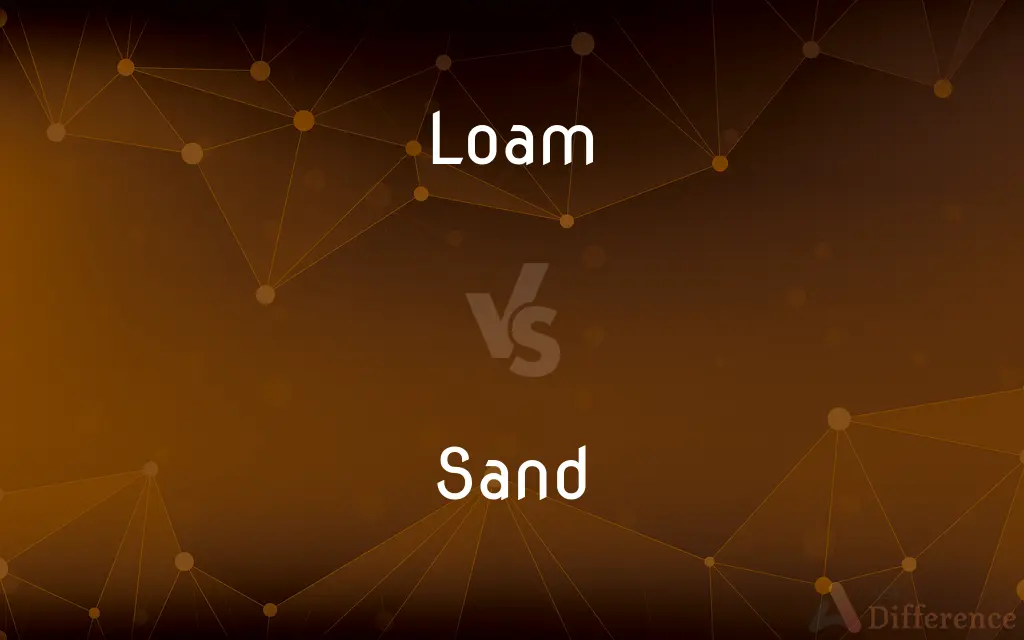Loam vs. Sand — What's the Difference?
By Tayyaba Rehman & Maham Liaqat — Updated on April 20, 2024
Loam is a rich soil type ideal for gardening due to its balanced mixture of sand, silt, and clay, providing excellent drainage and nutrient retention, whereas sand is coarse, drains quickly, and holds fewer nutrients.

Difference Between Loam and Sand
Table of Contents
ADVERTISEMENT
Key Differences
Loam is valued in agriculture and gardening for its optimal blend of different soil particles, which promotes water retention and aeration, while sand, predominantly consisting of coarse particles, tends to drain water very rapidly.
The texture of loam is soft and crumbly, which makes it easy to till and beneficial for root growth; on the other hand, sand has a gritty texture and does not hold together well, posing challenges for stabilizing plant roots.
Loam is typically fertile, supporting a wide variety of plant life due to its ability to retain nutrients effectively, whereas sand is often nutrient-poor and may require significant organic amendments to support healthy plant growth.
Because of its balanced structure, loam is less prone to compaction compared to other soil types, enhancing root penetration and moisture management; sand, however, despite not compacting, offers less support for roots due to its loose structure.
Loam maintains its moist consistency, which is ideal for most plants, while sand tends to dry out quickly, requiring more frequent watering to sustain plant life.
ADVERTISEMENT
Comparison Chart
Texture
Soft, crumbly
Gritty, loose
Drainage
Good, balanced
Very high
Nutrient Retention
High, retains nutrients well
Low, nutrients wash away quickly
Water Retention
High, maintains moisture
Low, dries out quickly
Best Uses
Gardening, agriculture
Drainage layers, foundations, sandboxes
Compare with Definitions
Loam
A soil composed of a mixture of sand, silt, and clay.
The farmer preferred loam for its ease of use and fertility.
Sand
Coarse-textured soil composed primarily of small rock and mineral particles.
Sand was spread over the icy walkway to provide traction.
Loam
Ideal for growing a wide range of plants due to its balanced properties.
Vegetables thrive in the loam, thanks to its excellent condition.
Sand
Requires frequent watering when used in gardens due to its poor water retention.
Sand in the desert garden must be irrigated twice daily.
Loam
Enhances water retention and aeration, supporting sustainable agriculture.
Watering is more efficient in loam because it retains moisture well.
Sand
Often needs to be amended with organic matter to support plant growth.
To grow roses in sand, considerable compost was mixed in.
Loam
Known for its dark, rich color and soft texture.
Loam covers much of the garden, promoting vigorous plant growth.
Sand
Drains water quickly and does not hold nutrients effectively.
Sand is often added to potted plant mixes to improve drainage.
Loam
Less likely to erode or compact than other soil types.
Despite heavy rains, the loam remained structurally sound.
Sand
Commonly used in construction and landscaping for its stability and drainage properties.
The contractor used sand as a base for the paving stones.
Loam
The definition of Loam (in geology and soil science) is soil composed mostly of sand (particle size > 63 micrometres (0.0025 in)), silt (particle size > 2 micrometres (7.9×10−5 in)), and a smaller amount of clay (particle size < 2 micrometres (7.9×10−5 in)). By weight, its mineral composition is about 40–40–20% concentration of sand–silt–clay, respectively.
Sand
Sand is a granular material composed of finely divided rock and mineral particles. Sand has various compositions but is defined by its grain size.
Loam
Soil composed of a mixture of sand, clay, silt, and organic matter.
Sand
Small loose grains of worn or disintegrated rock.
Loam
A mixture of moist clay and sand, and often straw, used especially in making bricks and foundry molds.
Sand
(Geology) A sedimentary material, finer than a granule and coarser than silt, with grains between 0.06 and 2.0 millimeters in diameter.
Loam
To fill, cover, or coat with loam.
Sand
Often sands A tract of land covered with sand, as a beach or desert.
Loam
(geology) A type of soil; an earthy mixture of sand, silt and clay, with organic matter to which its fertility is chiefly due.
Sand
The loose, granular, gritty particles in an hourglass.
Loam
(metalworking) A mixture of sand, clay, and other materials, used in making moulds for large castings, often without a pattern.
Sand
Sands Moments of allotted time or duration
"The sands are numb'red that makes up my life" (Shakespeare).
Loam
To cover, smear, or fill with loam.
Sand
(Slang) Courage; stamina; perseverance
"She had more sand in her than any girl I ever see.
In my opinion she was just full of sand" (Mark Twain).
Loam
Made of loam; consisting of loam.
Sand
A light grayish brown to yellowish gray.
Loam
A kind of soil; an earthy mixture of clay and sand, with organic matter to which its fertility is chiefly due.
We wash a wall of loam; we labor in vain.
Sand
To sprinkle or cover with or as if with sand.
Loam
A mixture of sand, clay, and other materials, used in making molds for large castings, often without a pattern.
Sand
To polish or scrape with sand or sandpaper.
Loam
To cover, smear, or fill with loam.
Sand
To mix with sand.
Loam
A rich soil consisting of a mixture of sand and clay and decaying organic materials
Sand
To fill up (a harbor) with sand.
Sand
(uncountable) Rock that is ground more finely than gravel, but is not as fine as silt (more formally, see grain sizes chart), forming beaches and deserts and also used in construction.
Sand
A beach or other expanse of sand.
The Canadian tar sands are a promising source of oil.
Sand
Personal courage.
Sand
A particle from 62.5 microns to 2 mm in diameter, following the Wentworth scale.
Sand
A light beige colour, like that of typical sand.
Sand
A single grain of sand.
Sand
A moment or interval of time; the term or extent of one's life (referring to the sand in an hourglass).
Sand
(colloquial) A sandpiper.
Sand
Of a light beige colour, like that of typical sand.
Sand
(transitive) To abrade the surface of (something) with sand or sandpaper in order to smooth or clean it.
Sand
(transitive) To cover with sand.
Sand
To blot ink using sand.
Sand
Fine particles of stone, esp. of siliceous stone, but not reduced to dust; comminuted stone in the form of loose grains, which are not coherent when wet.
That finer matter, called sand, is no other than very small pebbles.
Sand
A single particle of such stone.
Sand
The sand in the hourglass; hence, a moment or interval of time; the term or extent of one's life.
The sands are numbered that make up my life.
Sand
Tracts of land consisting of sand, like the deserts of Arabia and Africa; also, extensive tracts of sand exposed by the ebb of the tide.
Sand
Courage; pluck; grit.
Sand
To sprinkle or cover with sand.
Sand
To drive upon the sand.
Sand
To bury (oysters) beneath drifting sand or mud.
Sand
To mix with sand for purposes of fraud; as, to sand sugar.
Sand
A loose material consisting of grains of rock or coral
Sand
French writer known for works concerning women's rights and independence (1804-1876)
Sand
Fortitude and determination;
He didn't have the guts to try it
Sand
Rub with sandpaper;
Sandpaper the wooden surface
Common Curiosities
How does sand affect plant growth?
Sand can negatively affect plant growth due to poor nutrient and water retention unless properly amended.
What makes loam ideal for water conservation?
Loam conserves water by retaining moisture more effectively than sandy soils.
Does sand naturally occur in gardens?
Sand can naturally occur in gardens, especially in coastal or arid areas.
Why is sand preferred for construction?
Sand is preferred for construction because of its compaction and drainage properties.
How do I improve sandy soil for planting?
Mixing organic compost or clay can improve sandy soil's water and nutrient retention.
What is loam soil used for?
Loam is primarily used in gardening and agriculture due to its fertility and ideal growing conditions.
Can loam prevent soil erosion?
Yes, loam can help prevent erosion due to its cohesive properties and moisture retention.
Can you turn sand into loam?
Yes, by adding silt, clay, and organic matter, sand can be improved to create a loam-like soil.
Is loam good for all types of plants?
Loam is suitable for most plants, offering a balance of drainage and nutrient availability.
How can I identify loam soil?
Loam soil can be identified by its soft, crumbly texture and rich color.
What are the drawbacks of using sand in agriculture?
The major drawback is its inability to hold water and nutrients, making it less ideal for most crops.
What is the difference in pH preference for loam versus sand?
Loam generally supports a wider pH range due to its balanced composition, whereas sandy soils often require specific adjustments depending on the crop.
What is the best way to water sandy soils?
Frequent, lighter watering sessions are best to prevent nutrient leaching in sandy soils.
How often should loam soil be fertilized?
Loam soil generally requires less frequent fertilization due to its ability to retain nutrients.
Are there plants that prefer sandy soil?
Yes, certain plants like cacti and succulents prefer the quick drainage that sandy soils offer.
Share Your Discovery

Previous Comparison
Goad vs. Prod
Next Comparison
Locus vs. LociAuthor Spotlight
Written by
Tayyaba RehmanTayyaba Rehman is a distinguished writer, currently serving as a primary contributor to askdifference.com. As a researcher in semantics and etymology, Tayyaba's passion for the complexity of languages and their distinctions has found a perfect home on the platform. Tayyaba delves into the intricacies of language, distinguishing between commonly confused words and phrases, thereby providing clarity for readers worldwide.
Co-written by
Maham Liaqat















































